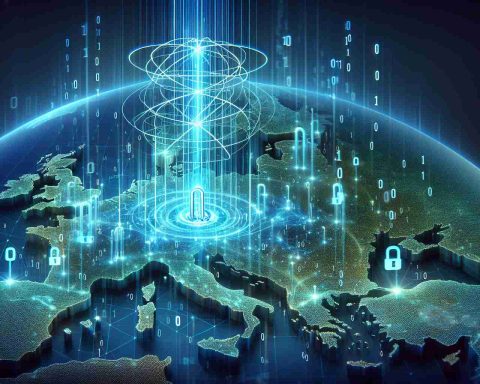- The European Quantum Communication Infrastructure (EuroQCI) aims to protect sensitive data using quantum key distribution (QKD).
- This initiative is crucial for securing government and personal communications, as well as critical infrastructure.
- EuroQCI plans to integrate terrestrial fiber-optic networks with an innovative satellite constellation for enhanced security.
- The first satellite in this constellation, Eagle-1, is scheduled for launch in 2026 to validate space-based QKD technologies.
- All 27 EU Member States unanimously support the initiative, highlighting its importance in global quantum capabilities.
- EuroQCI is poised to set a global standard for secure quantum communications, heralding a new era of cybersecurity.
Imagine a world where your sensitive data is shielded by the invincible power of quantum technology! The European Space Agency (ESA) and the European Commission have embarked on an exhilarating journey to create the European Quantum Communication Infrastructure (EuroQCI), a trailblazing network designed to safeguard critical communications with cutting-edge quantum key distribution (QKD).
This ambitious initiative is not merely about innovation; it’s a strategic leap towards ensuring that government data, personal information, and essential infrastructure—like power grids and emergency services—are fortified against emerging threats. By 2030, the EuroQCI aims to position the EU at the forefront of global quantum capabilities.
The dazzling EuroQCI system artfully melds terrestrial and celestial technologies. On land, existing fiber-optic networks are being turbocharged with quantum-enhanced security features. In the skies, the ESA is busy crafting a satellite constellation under its Scylight program, with the first satellite, Eagle-1, slated for launch in 2026. This pioneering satellite will test and validate space-based QKD technologies, ensuring that Europe stays ahead of the quantum curve.
This groundbreaking project has garnered unanimous support from all 27 EU Member States, a testament to its critical significance. As the ESA’s Director General passionately pointed out, EuroQCI is set to establish a global benchmark for secure quantum communication.
The takeaway? Europe is stepping boldly into the quantum future, combining terrestrial and satellite technologies to create an ironclad defense against cyber threats. Get ready for a new era of security that could change the way we communicate forever!
Unlocking the Future: Europe’s Quantum Communication Revolution
The European Quantum Communication Infrastructure (EuroQCI)
The European Quantum Communication Infrastructure (EuroQCI) represents a pivotal initiative undertaken by the European Space Agency (ESA) and the European Commission to bolster communication security across the continent. Leveraging quantum key distribution (QKD), this ambitious project aims to protect sensitive data from emerging cyber threats. By 2030, the EuroQCI is set to place the European Union at the leading edge of global quantum technology developments.
Innovations and Features of EuroQCI
– Quantum Key Distribution (QKD): The heart of EuroQCI is its application of quantum cryptography, which allows for the secure exchange of encryption keys through quantum principles. This ensures that any attempt to intercept the communication is detectable.
– Terrestrial and Satellite Integration: The EuroQCI network will seamlessly blend existing fiber-optic networks with new satellite technology. The ESA is developing the Scylight satellite constellation, starting with the Eagle-1 satellite slated for launch in 2026.
– Universal Support: The EuroQCI initiative has received unanimous backing from all 27 EU member states, underscoring its importance to European security and technological advancement.
Pricing and Market Forecasts
While specific pricing details have not been released, significant investment is expected from the EU and its member states, with potential estimates in the billions of euros over the project lifespan. As for market forecasts, the global quantum cryptography market is projected to grow significantly, with estimates reaching a valuation of USD 4 billion by 2025. This growth indicates a lucrative horizon for cybersecurity industries involved in quantum technologies.
Limitations and Challenges
Despite its revolutionary potential, several challenges still lie ahead:
– Technical Complexity: Implementing QKD and integrating it with existing infrastructures present substantial engineering hurdles.
– Public Acceptance and Understanding: There may be a steep learning curve and some resistance among organizations and the public regarding the new technologies and their benefits.
– Regulatory Frameworks: Establishing adequate legal frameworks to manage quantum communications and security will be crucial to the initiative’s success.
Security Aspects
The EuroQCI ultimately aims to create a robust defense mechanism against cyber threats, not only for government bodies but also for critical infrastructure services such as healthcare and emergency services. The evolving threat landscape, including increasingly sophisticated cyber-attacks, necessitates the development of quantum-resistant security protocols.
FAQs
1. What is Quantum Key Distribution (QKD), and how does it work?
Quantum Key Distribution (QKD) allows two parties to generate a shared, secret random key, which can be used for secure communication. It utilizes the principles of quantum mechanics to ensure the security of the key exchange, making it impossible for an eavesdropper to intercept the key without detection.
2. How does the EuroQCI benefit everyday citizens?
The EuroQCI will enhance the security of personal and sensitive data, significantly lowering the risks of data breaches and cyber attacks. This will protect everything from personal correspondence to crucial infrastructure, ultimately ensuring greater privacy and safety for citizens.
3. What is the timeline for the EuroQCI?
The first satellite in the Scylight program, Eagle-1, is scheduled for launch in 2026, with the full EuroQCI operational by 2030. The phased deployment will enable continuous improvement and integration of quantum technologies across Europe.
For more information on this groundbreaking initiative, visit the European Space Agency.
The source of the article is from the blog karacasanime.com.ve
















